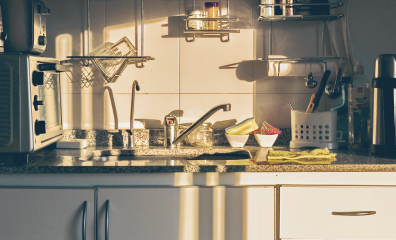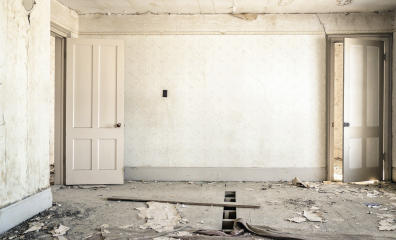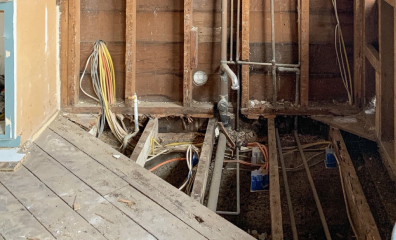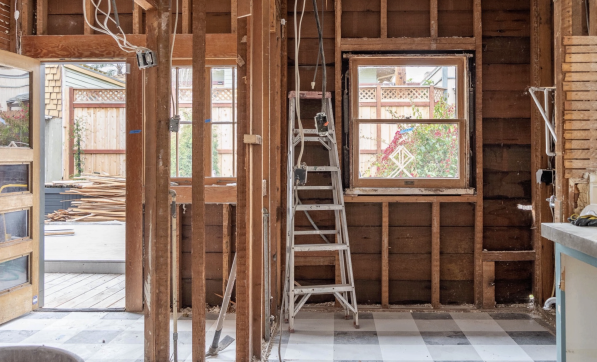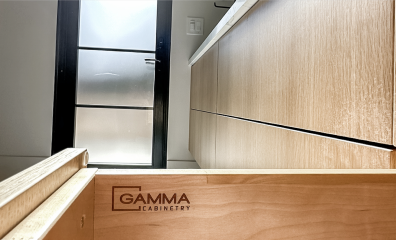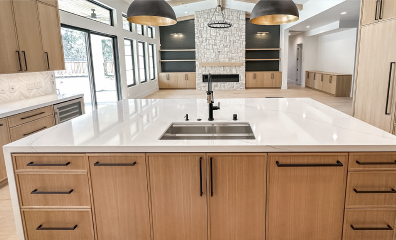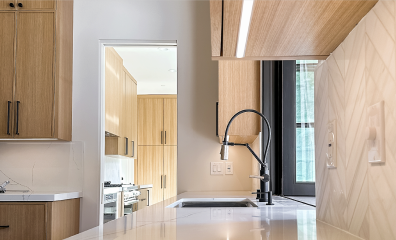All About
Kitchen Remodeling
A custom kitchen remodel is an opportunity to transform the heart of your home. Imagine starting a new journey – a custom kitchen remodel. This trip involves making design decisions, picking out cool materials, watching them all come together, and maybe even juggling a few life routines during the process. With a good team and a solid plan in place, the end result is a satisfying victory: a kitchen that’s a perfect fit for everyday needs and a unique personal style.
The Design Phase: The cornerstone of any kitchen remodel is the design. It is during this stage that you determine the look and feel of your kitchen. From choosing your color scheme to finalizing the layout, every detail is crucial. You may consider working with a kitchen designer, who can offer professional insights that bring your kitchen remodel vision to life. Kitchen remodel designs range from traditional to contemporary styles, and it’s essential to select a style that complements your home’s overall aesthetic.
Selection of Appliances: The kitchen remodel process often begins with appliance selection. The size and type of your appliances, such as the refrigerator, stove, dishwasher, and other special amenities, can significantly influence your kitchen’s layout. The kitchen remodel design should incorporate the appliances seamlessly, ensuring a balance between aesthetic appeal and functional utility.
Custom Cabinets and Countertops: When you embark on a custom kitchen remodel, the cabinets and countertops take center stage. Your choice in these elements shapes the kitchen’s character and functionality. The kitchen remodel process allows you to specify materials, styles, and colors for your cabinets and countertops, aligning these key features with your desired aesthetic and practical needs.
Lighting in Kitchen Remodel: Lighting is an often underrated, yet crucial aspect of a kitchen remodel. The lighting arrangement should cater to the three main types: ambient for general illumination, task lighting for specific work areas, and accent lighting to highlight the kitchen remodel design features.
Plumbing and Electrical Considerations: Every kitchen remodel involves intricate plumbing and electrical work. Aligning these elements with building regulations is a detailed process that forms an invisible, yet essential part of the kitchen remodel. This ensures your kitchen is safe and meets all necessary codes.
Flooring Options: Flooring is another vital feature in a kitchen remodel. It’s not just about choosing visually pleasing flooring – the material must also withstand the kitchen’s high traffic and ease of cleaning. Your chosen flooring should complement the kitchen remodel design, tying the space together aesthetically.
Building and Installation Process: The actual building and installation part of the kitchen remodel is where your plans start taking physical shape. This phase can involve a variety of tasks, including demolition, framing, installing plumbing and electrical systems, putting in custom cabinetry, countertops, appliances, painting, and more. Your kitchen remodel comes to life step by step, and each must be completed before moving on to the next.
Budgeting for a Kitchen Remodel: Custom kitchen remodels can be a significant investment. The level of personalization, along with the quality of materials chosen, can drive costs up. It’s important to set a realistic budget for your kitchen remodel, factoring in potential extra costs.
Timeframe of a Kitchen Remodel: Depending on the extent of the work involved, a kitchen remodel can span several weeks to months. Patience is key throughout a kitchen remodel, as rushing can lead to mistakes or oversights.
Professional Help: A custom kitchen remodel is not a job for the inexperienced. Hiring professionals, such as a general contractor, kitchen designer, plumber, and electrician, ensures your kitchen remodel is completed to a high standard, following all necessary codes.
Living Arrangements during a Kitchen Remodel: Your kitchen will be unusable during the remodel. It’s essential to plan for how you’ll manage without a fully functioning kitchen, which may involve setting up a temporary kitchen, eating out, or even temporarily moving out.
A custom kitchen remodel is a detailed process, requiring careful planning, patience, and professional expertise. From design to installation, each element—appliances, custom cabinets, lighting, plumbing, and flooring—plays a pivotal role. Despite its complexity and potential challenges, a well-executed kitchen remodel offers a rewarding outcome: a space that marries personal style with functionality.
The Design Phase: The cornerstone of any kitchen remodel is the design. It is during this stage that you determine the look and feel of your kitchen. From choosing your color scheme to finalizing the layout, every detail is crucial. You may consider working with a kitchen designer, who can offer professional insights that bring your kitchen remodel vision to life. Kitchen remodel designs range from traditional to contemporary styles, and it’s essential to select a style that complements your home’s overall aesthetic.
Selection of Appliances: The kitchen remodel process often begins with appliance selection. The size and type of your appliances, such as the refrigerator, stove, dishwasher, and other special amenities, can significantly influence your kitchen’s layout. The kitchen remodel design should incorporate the appliances seamlessly, ensuring a balance between aesthetic appeal and functional utility.
Custom Cabinets and Countertops: When you embark on a custom kitchen remodel, the cabinets and countertops take center stage. Your choice in these elements shapes the kitchen’s character and functionality. The kitchen remodel process allows you to specify materials, styles, and colors for your cabinets and countertops, aligning these key features with your desired aesthetic and practical needs.
Lighting in Kitchen Remodel: Lighting is an often underrated, yet crucial aspect of a kitchen remodel. The lighting arrangement should cater to the three main types: ambient for general illumination, task lighting for specific work areas, and accent lighting to highlight the kitchen remodel design features.
Plumbing and Electrical Considerations: Every kitchen remodel involves intricate plumbing and electrical work. Aligning these elements with building regulations is a detailed process that forms an invisible, yet essential part of the kitchen remodel. This ensures your kitchen is safe and meets all necessary codes.
Flooring Options: Flooring is another vital feature in a kitchen remodel. It’s not just about choosing visually pleasing flooring – the material must also withstand the kitchen’s high traffic and ease of cleaning. Your chosen flooring should complement the kitchen remodel design, tying the space together aesthetically.
Building and Installation Process: The actual building and installation part of the kitchen remodel is where your plans start taking physical shape. This phase can involve a variety of tasks, including demolition, framing, installing plumbing and electrical systems, putting in custom cabinetry, countertops, appliances, painting, and more. Your kitchen remodel comes to life step by step, and each must be completed before moving on to the next.
Budgeting for a Kitchen Remodel: Custom kitchen remodels can be a significant investment. The level of personalization, along with the quality of materials chosen, can drive costs up. It’s important to set a realistic budget for your kitchen remodel, factoring in potential extra costs.
Timeframe of a Kitchen Remodel: Depending on the extent of the work involved, a kitchen remodel can span several weeks to months. Patience is key throughout a kitchen remodel, as rushing can lead to mistakes or oversights.
Professional Help: A custom kitchen remodel is not a job for the inexperienced. Hiring professionals, such as a general contractor, kitchen designer, plumber, and electrician, ensures your kitchen remodel is completed to a high standard, following all necessary codes.
Living Arrangements during a Kitchen Remodel: Your kitchen will be unusable during the remodel. It’s essential to plan for how you’ll manage without a fully functioning kitchen, which may involve setting up a temporary kitchen, eating out, or even temporarily moving out.
A custom kitchen remodel is a detailed process, requiring careful planning, patience, and professional expertise. From design to installation, each element—appliances, custom cabinets, lighting, plumbing, and flooring—plays a pivotal role. Despite its complexity and potential challenges, a well-executed kitchen remodel offers a rewarding outcome: a space that marries personal style with functionality.
